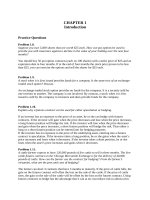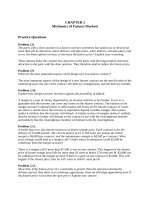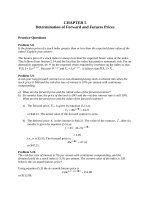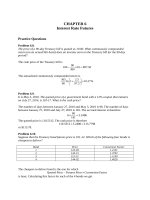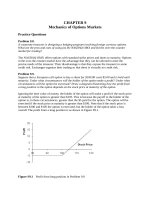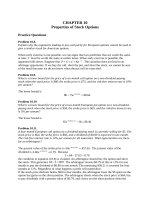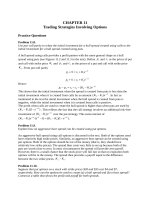Solutions fundamentals of futures and options markets 7e by hull chapter 06
Bạn đang xem bản rút gọn của tài liệu. Xem và tải ngay bản đầy đủ của tài liệu tại đây (81.87 KB, 10 trang )
CHAPTER 6
Interest Rate Futures
Practice Questions
Problem 6.8.
The price of a 90-day Treasury bill is quoted as 10.00. What continuously compounded
return (on an actual/365 basis) does an investor earn on the Treasury bill for the 90-day
period?
The cash price of the Treasury bill is
100 −
90
×10 = $97.50
360
The annualized continuously compounded return is
365
2.5
ln 1 +
÷ = 10.27%
90 97.5
Problem 6.9.
It is May 5, 2010. The quoted price of a government bond with a 12% coupon that matures
on July 27, 2014, is 110-17. What is the cash price?
The number of days between January 27, 2010 and May 5, 2010 is 98. The number of days
between January 27, 2010 and July 27, 2010 is 181. The accrued interest is therefore
98
6×
= 3.2486
181
The quoted price is 110.5312. The cash price is therefore
110.5312 + 3.2486 = 113.7798
or $113.78.
Problem 6.10.
Suppose that the Treasury bond futures price is 101-12. Which of the following four bonds is
cheapest to deliver?
Bond
1
2
3
4
Price
125-05
142-15
115-31
144-02
Conversion Factor
1.2131
1.3792
1.1149
1.4026
The cheapest-to-deliver bond is the one for which
Quoted Price − Futures Price × Conversion Factor
is least. Calculating this factor for each of the 4 bonds we get
Bond 1 : 125.15625 − 101.375 ×1.2131 = 2.178
Bond 2 : 142.46875 − 101.375 ×1.3792 = 2.652
Bond 3 : 115.96875 − 101.375 ×1.1149 = 2.946
Bond 4 : 144.06250 − 101.375 ×1.4026 = 1.874
Bond 4 is therefore the cheapest to deliver.
Problem 6.11.
It is July 30, 2012. The cheapest-to-deliver bond in a September 2012 Treasury bond futures
contract is a 13% coupon bond, and delivery is expected to be made on September 30, 2012.
Coupon payments on the bond are made on February 4 and August 4 each year. The term
structure is flat, and the rate of interest with semiannual compounding is 12% per annum.
The conversion factor for the bond is 1.5. The current quoted bond price is $110. Calculate
the quoted futures price for the contract.
There are 176 days between February 4 and July 30 and 181 days between February 4 and
August 4. The cash price of the bond is, therefore:
176
110 +
× 6.5 = 116.32
181
The rate of interest with continuous compounding is 2 ln1.06 = 0.1165 or 11.65% per annum.
A coupon of 6.5 will be received in 5 days ( = 0.01366 years) time. The present value of the
coupon is
6.5e−0.01366×0.1165 = 6.490
The futures contract lasts for 62 days ( = 0.1694 years). The cash futures price if the contract
were written on the 13% bond would be
(116.32 − 6.490)e0.1694×0.1165 = 112.02
At delivery there are 57 days of accrued interest. The quoted futures price if the contract were
written on the 13% bond would therefore be
57
112.02 − 6.5 ×
= 110.01
184
Taking the conversion factor into account the quoted futures price should be:
110.01
= 73.34
1.5
Problem 6.12.
An investor is looking for arbitrage opportunities in the Treasury bond futures market. What
complications are created by the fact that the party with a short position can choose to
deliver any bond with a maturity of over 15 years?
If the bond to be delivered and the time of delivery were known, arbitrage would be
straightforward. When the futures price is too high, the arbitrageur buys bonds and shorts an
equivalent number of bond futures contracts. When the futures price is too low, the
arbitrageur shorts bonds and goes long an equivalent number of bond futures contracts.
Uncertainty as to which bond will be delivered introduces complications. The bond that
appears cheapest-to-deliver now may not in fact be cheapest-to-deliver at maturity. In the
case where the futures price is too high, this is not a major problem since the party with the
short position (i.e., the arbitrageur) determines which bond is to be delivered. In the case
where the futures price is too low, the arbitrageur’s position is far more difficult since he or
she does not know which bond to short; it is unlikely that a profit can be locked in for all
possible outcomes.
Problem 6.13.
Suppose that the nine-month LIBOR interest rate is 8% per annum and the six-month LIBOR
interest rate is 7.5% per annum (both with actual/365 and continuous compounding).
Estimate the three-month Eurodollar futures price quote for a contract maturing in six
months.
The forward interest rate for the time period between months 6 and 9 is 9% per annum with
continuous compounding. This is because 9% per annum for three months when combined
with 7 12 % per annum for six months gives an average interest rate of 8% per annum for the
nine-month period.
With quarterly compounding the forward interest rate is
4(e0.09 / 4 − 1) = 0.09102
or 9.102%. This assumes that the day count is actual/actual. With a day count of actual/360
the rate is 9.102 × 360 / 365 = 8.977 . The three-month Eurodollar quote for a contract
maturing in six months is therefore
100 − 8.977 = 91.02
Problem 6.14.
A five-year bond with a yield of 11% (continuously compounded) pays an 8% coupon at the
end of each year.
a) What is the bond’s price?
b) What is the bond’s duration?
c) Use the duration to calculate the effect on the bond’s price of a 0.2% decrease in its
yield.
d) Recalculate the bond’s price on the basis of a 10.8% per annum yield and verify that
the result is in agreement with your answer to (c).
a) The bond’s price is
8e −0.11 + 8e −0.11×2 + 8e −0.11×3 + 8e −0.11×4 + 108e −0.11×5 = 86.80
b) The bond’s duration is
1 −0.11
+ 2 × 8e −0.11×2 + 3 × 8e−0.11×3 + 4 × 8e−0.11×4 + 5 ×108e −0.11×5
8e
86.80
= 4.256years
c) Since, with the notation in the chapter
∆B = − BD∆y
the effect on the bond’s price of a 0.2% decrease in its yield is
86.80 × 4.256 × 0.002 = 0.74
The bond’s price should increase from 86.80 to 87.54.
d) With a 10.8% yield the bond’s price is
8e −0.108 + 8e−0.108×2 + 8e−0.108×3 + 8e−0.108×4 + 108e−0.108×5 = 87.54
This is consistent with the answer in (c).
Problem 6.15.
Suppose that a bond portfolio with a duration of 12 years is hedged using a futures contract
in which the underlying asset has a duration of four years. What is likely to be the impact on
the hedge of the fact that the 12-year rate is less volatile than the four-year rate?
Duration-based hedging procedures assume parallel shifts in the yield curve. Since the 12year rate tends to move by less than the 4-year rate, the portfolio manager may find that he or
she is over-hedged.
Problem 6.16.
Suppose that it is February 20 and a treasurer realizes that on July 17 the company will have
to issue $5 million of commercial paper with a maturity of 180 days. If the paper were issued
today, the company would realize $4,820,000. (In other words, the company would receive
$4,820,000 for its paper and have to redeem it at $5,000,000 in 180 days’ time.) The
September Eurodollar futures price is quoted as 92.00. How should the treasurer hedge the
company’s exposure?
The company treasurer can hedge the company’s exposure by shorting Eurodollar futures
contracts. The Eurodollar futures position leads to a profit if rates rise and a loss if they fall.
The duration of the commercial paper is twice that of the Eurodollar deposit underlying the
Eurodollar futures contract. The contract price of a Eurodollar futures contract is 980,000.
The number of contracts that should be shorted is, therefore,
4, 820, 000
× 2 = 9.84
980, 000
Rounding to the nearest whole number 10 contracts should be shorted.
Problem 6.17.
On August 1 a portfolio manager has a bond portfolio worth $10 million. The duration of the
portfolio in October will be 7.1 years. The December Treasury bond futures price is currently
91-12 and the cheapest-to-deliver bond will have a duration of 8.8 years at maturity. How
should the portfolio manager immunize the portfolio against changes in interest rates over
the next two months?
The treasurer should short Treasury bond futures contract. If bond prices go down, this
futures position will provide offsetting gains. The number of contracts that should be shorted
is
10, 000, 000 × 7.1
= 88.30
91, 375 × 8.8
Rounding to the nearest whole number 88 contracts should be shorted.
Problem 6.18.
How can the portfolio manager change the duration of the portfolio to 3.0 years in Problem
6.17?
The answer in Problem 6.17 is designed to reduce the duration to zero. To reduce the duration
from 7.1 to 3.0 instead of from 7.1 to 0, the treasurer should short
or 51 contracts.
4.1
× 88.30 = 50.99
7.1
Problem 6.19.
Between October 30, 2012, and November 1, 2012, you have a choice between owning a U.S.
government bond paying a 12% coupon and a U.S. corporate bond paying a 12% coupon.
Consider carefully the day count conventions discussed in this chapter and decide which of
the two bonds you would prefer to own. Ignore the risk of default.
You would prefer to own the Treasury bond. Under the 30/360 day count convention there is
one day between October 30 and November 1. Under the actual/actual (in period) day count
convention, there are two days. Therefore you would earn approximately twice as much
interest by holding the Treasury bond.
Problem 6.20.
Suppose that a Eurodollar futures quote is 88 for a contract maturing in 60 days. What is the
LIBOR forward rate for the 60- to 150-day period? Ignore the difference between futures and
forwards for the purposes of this question.
The Eurodollar futures contract price of 88 means that the Eurodollar futures rate is 12% per
annum with quarterly compounding. This is the forward rate for the 60- to 150-day period
with quarterly compounding and an actual/360 day count convention.
Problem 6.21.
The three-month Eurodollar futures price for a contract maturing in six years is quoted as
95.20. The standard deviation of the change in the short-term interest rate in one year is
1.1%. Estimate the forward LIBOR interest rate for the period between 6.00 and 6.25 years
in the future.
Using the notation of Section 6.3, σ = 0.011 , t1 = 6 , and t2 = 6.25 . The convexity adjustment
is
1
× 0.0112 × 6 × 6.25 = 0.002269
2
or about 23 basis points. The futures rate is 4.8% with quarterly compounding and an
actual/360 day count. This becomes 4.8 × 365 / 360 = 4.867% with an actual/actual day count.
It is 4 ln(1 + .04867 / 4) = 4.84% with continuous compounding. The forward rate is therefore
4.84 − 0.23 = 4.61% with continuous compounding.
Problem 6.22.
Explain why the forward interest rate is less than the corresponding futures interest rate
calculated from a Eurodollar futures contract.
Suppose that the contracts apply to the interest rate between times T1 and T2 . There are two
reasons for a difference between the forward rate and the futures rate. The first is that the
futures contract is settled daily whereas the forward contract is settled once at time T2 . The
second is that without daily settlement a futures contract would be settled at time T1 not T2 .
Both reasons tend to make the futures rate greater than the forward rate.
Further Questions
Problem 6.23
The December Eurodollar futures contract is quoted as 98.40 and a company plans to
borrow $8 million for three months starting in December at LIBOR plus 0.5%.
(a) What rate can then company lock in by using the Eurodollar futures contract?
(b) What position should the company take in the contracts?
(c) If the actual three-month rate turns out to be 1.3%, what is the final settlement price on
the futures contracts.
Ignore timing mismatches between the cash flows from the Eurodollar futures contract and
interest rate cash flows.
(a) The company can lock in a 3-month LIBOR rate of 100 − 98.4 =1.60%. The rate it pays is
therefore locked in at 1.6 + 0.5 = 2.1%.
(b) The company should sell (i.e., short) 8 contracts. If rates increase, the LIBOR quote goes
down and the company gains on the futures. Similarly, if rates decrease, the LIBOR quote
goes up and the company loses on the futures.
(c) The final settlement price is 100 − 1.30 = 98.70.
Problem 6.24
A Eurodollar futures quote for the period between 5.1 and 5.35 year in the future is 97.1. The
standard deviation of the change in the short-term interest rate in one year is 1.4%. Estimate
the forward interest rate in an FRA.
The futures rate is 2.9%. The forward rate can be estimated using equation (6.3) as
0.029 − 0.5× 0.0142 ×5.1×5.35 = 0.0263
or 2.63%.
Problem 6.25
It is March 10, 2011. The cheapest-to-deliver bond in a December 2010 Treasury bond
futures contract is an 8% coupon bond, and delivery is expected to be made on December 31
31, 2011. Coupon payments on the bond are made on March 1 and September 1 each year.
The term structure is flat, and the rate of interest with continuous compounding is 5% per
annum. The conversion factor for the bond is 1.2191. The current quoted bond price is $137.
Calculate the quoted futures price for the contract.
The cash bond price is currently
9
× 4 = 137.1957
184
A coupon of 4 will be received after 175 days or 0.4795 years. The present value of the
coupon on the bond is 4e-0.05×0.4795=3.9053. The futures contract lasts 295 days or 0.8082 years.
The cash futures price if it were written on the 8% bond would therefore be
(137.1957 − 3.9053)e0.05×0.8082 =138.7871
At delivery there are 121 days of accrued interest. The quoted futures if the contract were
written on the 85 bond would therefore be
137 +
138.7871 − 4 ×
121
= 136.1278
182
The quoted price should therefore be
136.1278
= 111 .66
1.2191
Problem 6.26.
Assume that a bank can borrow or lend money at the same interest rate in the LIBOR market.
The 90-day rate is 10% per annum, and the 180-day rate is 10.2% per annum, both
expressed with continuous compounding. The Eurodollar futures price for a contract
maturing in 91 days is quoted as 89.5. What arbitrage opportunities are open to the bank?
The Eurodollar futures contract price of 89.5 means that the Eurodollar futures rate is 10.5%
per annum with quarterly compounding and an actual/360 day count. This becomes
10.5 × 365 / 360 = 10.646% with an actual/actual day count. This is
4 ln(1 + 0.25 × 0.10646) = 0.1051
or 10.51% with continuous compounding. The forward rate given by the 90-day rate and the
180-day rate is 10.4% with continuous compounding. This suggests the following arbitrage
opportunity:
1.
Buy Eurodollar futures.
2.
Borrow 180-day money.
3.
Invest the borrowed money for 90 days.
Problem 6.27.
A Canadian company wishes to create a Canadian LIBOR futures contract from a U.S.
Eurodollar futures contract and forward contracts on foreign exchange. Using an example,
explain how the company should proceed. For the purposes of this problem, assume that a
futures contract is the same as a forward contract.
The U.S. Eurodollar futures contract maturing at time T enables an investor to lock in the
forward rate for the period between T and T ∗ where T ∗ is three months later than T . If rˆ is
the forward rate, the U.S. dollar cash flows that can be locked in are
∗
− Ae − rˆ(T −T ) at time T
+A
at time T ∗
where A is the principal amount. To convert these to Canadian dollar cash flows, the
Canadian company must enter into a short forward foreign exchange contract to sell
Canadian dollars at time T and a long forward foreign exchange contract to buy Canadian
dollars at time T ∗ . Suppose F and F ∗ are the forward exchange rates for contracts maturing
at times T and T ∗ . (These represent the number of Canadian dollars per U.S. dollar.) The
Canadian dollars to be sold at time T are
∗
Ae − rˆ(T −T ) F
and the Canadian dollars to be purchased at time T ∗ are
AF ∗
The forward contracts convert the U.S. dollar cash flows to the following Canadian dollar
cash flows:
∗
− Ae− rˆ(T −T ) F at time T
+ AF ∗
at time T ∗
This is a Canadian dollar LIBOR futures contract where the principal amount is AF ∗ .
Problem 6.28.
Portfolio A consists of a one-year zero-coupon bond with a face value of $2,000 and a 10year zero-coupon bond with a face value of $6,000. Portfolio B consists of a 5.95-year zerocoupon bond with a face value of $5,000. The current yield on all bonds is 10% per annum.
(a) Show that both portfolios have the same duration.
(b) Show that the percentage changes in the values of the two portfolios for a 0.1% per
annum increase in yields are the same.
(c) What are the percentage changes in the values of the two portfolios for a 5% per
annum increase in yields?
a) The duration of Portfolio A is
1× 2000e −0.1×1 + 10 × 6000e −0.1×10
= 5.95
2000e −0.1×1 + 6000e−0.1×10
Since this is also the duration of Portfolio B, the two portfolios do have the same
duration.
b) The value of Portfolio A is
2000e−0.1 + 6000e −0.1×10 = 4016.95
When yields increase by 10 basis points its value becomes
2000e −0.101 + 6000e −0.101×10 = 3993.18
The percentage decrease in value is
23.77 ×100
= 0.59%
4016.95
The value of Portfolio B is
5000e −0.1×5.95 = 2757.81
When yields increase by 10 basis points its value becomes
5000e −0.101×5.95 = 2741.45
The percentage decrease in value is
16.36 ×100
= 0.59%
2757.81
The percentage changes in the values of the two portfolios for a 10 basis point
increase in yields are therefore the same.
c) When yields increase by 5% the value of Portfolio A becomes
2000e −0.15 + 6000e −0.15×10 = 3060.20
and the value of Portfolio B becomes
5000e −0.15×5.95 = 2048.15
The percentage reduction in the values of the two portfolios are:
956.75
Portfolio A :
×100 = 23.82
4016.95
709.66
Portfolio B :
×100 = 25.73
2757.81
Since the percentage decline in value of Portfolio A is less than that of Portfolio B,
Portfolio A has a greater convexity (see Figure 6.2 in text).
Problem 6.29.
It is June 25, 2010. The futures price for the June 2010 CBOT bond futures contract is 11823.
a.
Calculate the conversion factor for a bond maturing on January 1, 2026, paying a
coupon of 10%.
b.
Calculate the conversion factor for a bond maturing on October 1, 2031, paying
coupon of 7%.
c.Suppose that the quoted prices of the bonds in (a) and (b) are 169.00 and 136.00,
respectively. Which bond is cheaper to deliver?
d.
Assuming that the cheapest to deliver bond is actually delivered, what is the cash price
received for the bond?
a) On the first day of the delivery month the bond has 15 years and 7 months to maturity.
The value of the bond assuming it lasts 15.5 years and all rates are 6% per annum
with semiannual compounding is
31
5
100
+
= 140.00
∑
i
1.0331
i=1 1.03
The conversion factor is therefore 1.4000.
b) On the first day of the delivery month the bond has 21 years and 4 months to maturity.
The value of the bond assuming it lasts 21.25 years and all rates are 6% per annum
with semiannual compounding is
42
1
3.5
100
3
.
5
+
+
= 113.66
∑
i
1.0342
1.03
i=1 1.03
Subtracting the accrued interest of 1.75, this becomes 111.91. The conversion factor is
therefore 1.1191.
c) For the first bond, the quoted futures price times the conversion factor is
118.71825 × 1.4000 = 166.2056
This is 2.7944 less than the quoted bond price. For the second bond, the quoted
futures price times the conversion factor is
118.71825 × 1.1191 = 132.8576
This is 3.1424 less than the quoted bond price. The first bond is therefore the cheapest
to deliver.
d) The price received for the bond is 166.2056 plus accrued interest. There are 176 days
between January 1, 2010 and June 25, 2010. There are 181 days between January 1,
2010 and July 1, 2010. The accrued interest is therefore
176
5×
= 4.8619
181
The cash price received for the bond is therefore 171.0675.
Problem 6.30
A portfolio manager plans to use a Treasury bond futures contract to hedge a bond portfolio
over the next three months. The portfolio is worth $100 million and will have a duration of
4.0 years in three months. The futures price is 122, and each futures contract is on $100,000
of bonds. The bond that is expected to be cheapest to deliver will have a duration of 9.0 years
at the maturity of the futures contract. What position in futures contracts is required?
a. What adjustments to the hedge are necessary if after one month the bond that is expected
to be cheapest to deliver changes to one with a duration of seven years?
b. Suppose that all rates increase over the three months, but long-term rates increase less
than short-term and medium-term rates. What is the effect of this on the performance of
the hedge?
The number of short futures contracts required is
100, 000, 000 × 4.0
= 364.3
122, 000 × 9.0
Rounding to the nearest whole number 364 contracts should be shorted.
a. This increases the number of contracts that should be shorted to
100, 000, 000 × 4.0
= 468.4
122, 000 × 7.0
or 468 when we round to the nearest whole number.
b. In this case the gain on the short futures position is likely to be less than the loss on
the loss on the bond portfolio. This is because the gain on the short futures position
depends on the size of the movement in long-term rates and the loss on the bond
portfolio depends on the size of the movement in medium-term rates. Duration-based
hedging assumes that the movements in the two rates are the same.
